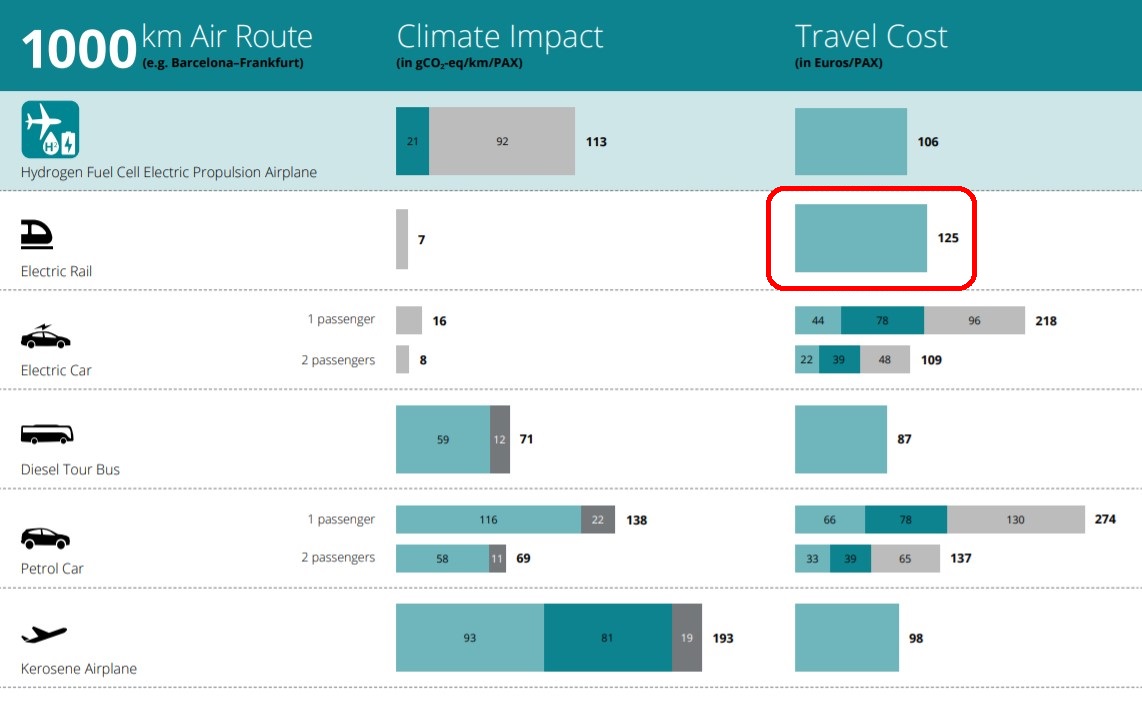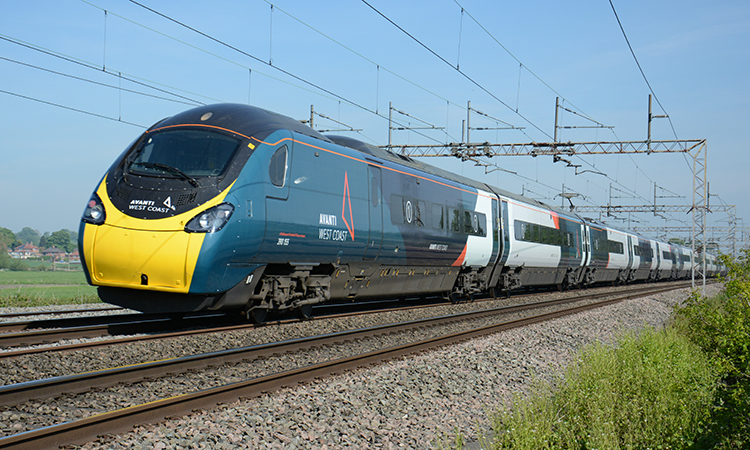28/06/2021 – By Frédéric de Kemmeter – Railway signalling and freelance copywriter – Suscribe my blog
(Version en français)
🟧 See also a review of railway news on this page
Since the green wave and the pandemic, the idea of replacing some flights with trains in Europe has gained momentum. The issue even taking spread when, in 2020, most countries had to intervene to support their airline. In addition, the Covid-19 crisis highlighted the benefits of empty skies and highways on air quality and reinvigorated the debate on whether governments should use public money to bail out polluting industries, aviation included. Unfortunately, as is always the case when politics is involved, we enter the realm of the irrational and sometimes out of touch with reality.
According a survey from Deloitte, globally, aviation connectivity is a strong driver of economic growth, jobs, trade and mobility. At the same time, the growth in air traffic demand needs to be concomitant with reducing aviation’s environmental footprint. The aviation industry is one of many industries that has a heavy impact on global human-made emissions. While aviation accounts for 2-3% of global carbon emissions today, if no changes are made in the sector this will increase to as much as 27% by 2050.

The current arguments try to show that decarbonisation of transport requires, in particular, the electrification of vehicle engines. However, trains have already been electric vehicles for decades and can take great advantage of this situation. We know in advance that there is very little chance that aircraft will have electric engines, as the constraints are enormous. On the other hand, the airline industry is already working on new zero-carbon fuels and is lobbying governments around the world. The « great replacement » that some people dream of is in danger of being derailed. Between the beliefs of some and the various studies of others, it is difficult to find one’s way. It is essential to distinguish between several elements.
First, the return to ‘normal life’ may indeed defy the best telephone surveys. The impression prevails that the thinking in 2021 may differ greatly from that in 2020. People have learned a lot from the pandemic and as soon as an opportunity for openness arises, attitudes change. The fact that in June traffic jams were once again the norm in major cities and that there was not a single seat left in restaurants in the evening is a clear indication that people are eager to return to their pre-2020 lifestyle. The same may be true for travel. At the beginning of June 2021, Eurocontrol reported a sharp increase in flights to over 11,000 per day, lower than in June 2019 but well above the 7,000 daily flights recorded in April 2021. Massive vaccination and gradual easing can be related to this upturn. Eurocontrol director-general Eamonn Brennan said: “If more states relax their restrictions and fully implement procedures such as the EU’s Digital Covid Certificate, [we] could see the network handling 69% of 2019 traffic levels in August.” Correct figures? Eamonn Brennan justified its forecast by demonstrating that at the end of January “we predicted the number of flights handled by the European network would be about 39% of 2019 levels in May, which was precisely what occurred. We are developing these numbers in close consultation with individual airlines across a large sample of airlines and market segments.” For many, flygskam is not a « big replacement » in favor of train travel but can allow to maintain a big pressure on the aviation industry to reform and dramatically reduce its carbon footprint.
Secondly, taking the issue of transport through ideology will clearly pose image problems. You create camps, with « good » and « bad » people, which polarises society. Researchers who study consumer profiles in different markets recently identified a new one: the “environmental traveller”. Today, there is a lot of environmental activism in favor of the train. This is obviously a good thing, but this militancy risks offending a whole section of travellers who don’t care political theses. Affirming the railways as a political and ideological tool is a sure-fire failure for the modal shift. The same researchers found that awareness of the environmental crisis doesn’t automatically translate into behavior changes, such as choosing other transport modes over air travel. Most often, distance or cost are more powerful motivations, particularly for short and medium-haul routes. It is therefore essential that the railways show more attractiveness as possible if we want the climate to be « everyone’s business », and not just a battle for a few activists. In this respect, there is still a lot of teaching to be done on both sides.

Thirdly, attitudes seem to be changing with regard to the length of train journeys. According Swiss banking group UBS, the general tolerance for longer rail trips is on the up with UBS data showing that business travelers would not mind journeys of four hours and leisure travelers willing to spend up to six hours on the train. UBS think that Europe will see high-speed rail network will grow by 10% every year over the next decade. One might even hope that by looking less at journey times, night trains could become a new way of travelling again. Why not? After all, if it is well designed, the night train is only ever a hotel on wheels. Interviewed by the BBC, Diana Oliveira, a 28-year-old PhD student from Portugal who runs The Nerdy Globetrotters social media accounts, recalls the problem of wearing masks on trains. “If you want to be protected as much as possible, then a flight seems like a good option, since the time exposure to others would be reduced,” she argues. “Secondly, it is a matter of convenience – wearing a face covering for two hours on a flight or for 10 hours on a train journey.” Here too, the train still has to show its best side.

In the end, what is most striking about this train vs. plane issue is the polarisation, even in academic circles. For example, a lot of academic research seems to want to interpret the flygskam movement as something « global ». They claim to be based on in-depth interviews with « many people ». But none of these studies indicate the socio-economic profile of the people surveyed, nor the plurality of the panel. The impression prevails that a public that is already militant and supportive of the climate cause is being surveyed. How many are they really in relation to the total population? No figures or mentions. Sometimes, if you look hard enough, you can see that some researchers are more committed than others. So beware. Between political wishful thinking and the reality of the world, only the sale of tickets will be able to tell us the exact extent of the modal shift.
Production costs will have to be tackled. The table below, from a Deloitte study, clearly shows that trains are more expensive than some flights over 1000km. Making rail expensive because of a bunch of industrial habits is a bad idea if you want modal shift. It is also anti-social because it makes the train a means of transport for those who can afford it. The cost structure of air travel is certainly a matter of debate – particularly with regard to taxing aviation fuel or VAT on tickets. But it is hard to believe that by taxing rail’s competitors, the railways would suddenly be reinvigorated. There is no consensus among researchers, academics and economists on this subject either.

The train is already an electric vehicle whose GHG emissions are much lower than those of other fossil-fueled transport. It should therefore be encouraged and made a reference transport. This can only be done by multiple actors, because state companies alone, subject to the vagaries of politics, will never succeed, as the history of rail has amply demonstrated. Let’s make it a more widely used form of transport and one that appeals to as many people as possible.
15/11/2021 – By Frédéric de Kemmeter – Railway signalling and freelance copywriter
Suscribe my blog
Related articles:
 The productive use of rail travel: what ask customers?
The productive use of rail travel: what ask customers?
03/08/2021 – How can we make the rail journey more timely? There is still a lot of work to be done, but rail has some arguments to achieve this. xxxxxxxxxxxxxxxxxxxxxxxxxxxxxxxxxxxxxxx xxxx
 Datas and mobile app: a new weapon to dominate
Datas and mobile app: a new weapon to dominate
02/01/2021 – How mobile app are becoming a weapon for one company to dominate rail transport. The question is whether this is how there will be a modal shift. xxxxxxxxxxxxxxxxxxxxxxxxxxxxxxxxxxxxxxx xxxx
 How the night train could be an asset for the railways
How the night train could be an asset for the railways
01/18/2021 – Sometimes a crisis can become an opportunity. This is what happened with the famous ocean liners, the passengers ships from the 1900s to the 1960s. The analogy with the night train is tempting. The night train can become a transport of the future if it is operated with a renewed business model.
 How can the train win back business travellers?
How can the train win back business travellers?
07/17/2020 – Business customers have high expectations when it comes to travel. The train can conquer this clientele but under certain conditions.xxxxxxxxxxxxxxxxxxxxxxxxxxxxxxxxxx
 What have you done with the railways in recent decades?
What have you done with the railways in recent decades?
04/05/2021 – « The market share of rail has not increased despite liberalization, » said the Portuguese minister. Why? This is explained in this article. xxxxxxxxxxxxxxxxxxxxxxxxxxxxxxxxxxxxxxx xxxx


Vous devez être connecté pour poster un commentaire.